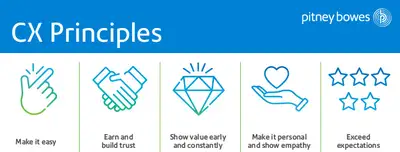How any organization can show value early and often to its clients
Everyone at Pitney Bowes strives to practice five core CX principles.

As part of recognizing global CX Day (October 5) at Pitney Bowes, I’d like to share some personal observations about how any organization can show value early and often to its clients.
Let clients define what’s valuable
How do you ensure that you’re delivering real value to clients? It doesn’t matter what role or job function you have — or where in the world your clients are — you must start with their definition of value, so you can deliver it to them from Day 1.
Client expectations can vary greatly, depending on context, customer segment, and other factors. Someone who’s booked a table at a 4-star restaurant will define value much differently than someone who has just completed a day-long drive and just wants a quick burger. Yet in both these scenarios, there are clear definitions of value, and they are all client-driven.
Business clients are also consumers, and like all of us they are immersed in amazing B2C experiences — enjoying speed and convenience that was unthinkable even ten years ago — and that has raised their expectations greatly. Businesses need to work extra hard to clear that high bar.
Be ready to respond to new calls for value
Your clients are the people who can best help you keep up. That means gathering information about what they want — before, during and after delivery of your product, service or solution. While every solution can’t be a bespoke one, you should be flexible enough to respond with value to new opportunities.
For example, when one of Pitney Bowes’ clients placed an unusually large order — one that called for an integrated web of hundreds of pieces of equipment spread across multiple geographies — we treated it like we were entering a battle against the failure to deliver value. We set up a war room and brought in senior management from every function. We hired and trained a small army of installers so we could handle the volume.
In the middle of this project, the client told us they selected us because “You showed us how you were going the extra mile and that made us feel we were in good hands.” Starting out with their confidence on our side was a nice to have but riding a wave of trust wasn’t enough. We had to deliver on their expectations, right from the start.
Bring clients into the process
Getting client input needs to be baked into every level of your culture and operations. To solve the client value equation, you need quantitative data (like product usage, or feature adoption) and qualitative data (like user testing input, or survey responses). With that information, you’ll discover insights that can help you deliver the right thing the first time around, or course correct quickly if your clients are telling you changes or improvements are needed.
A client’s definition of value can be individual and cultural. It’s so easy to frustrate a client by doing something which shows that you don’t see them, that you haven’t put them first. For example, when a client in Japan sees a half-translated feature, or a Swiss client sees product language that was obviously translated for a German audience, they can feel unimportant. Different cultures have different tolerance levels. Sometimes 80% ready is not good enough. You need to know when you need to hold off releasing products until they are more polished. This means you have to adopt to local cultures to succeed long term.
Make things personal
Despite our best efforts, we’ll inevitably get something wrong. When we do, we can nevertheless show value through our response.
The word sorry is an important word; use it when you need to. Regaining a client’s confidence means treating them as you’d treat anyone about whom you care deeply: by making it personal. Apologize, listen, empathize, and make amends. What that looks like can vary and should be guided by what’s important to them (for one client it may be a refund; for another it might be a freebie), but you must do something that meets or exceeds their expectations. Every failure to deliver value is a learning opportunity. Take your lessons and apply them to the experience going forward, so you can make it better for every client interaction that follows.
Delivering value is a matter of survival
If you don’t deliver value to clients on their terms, you’ll go extinct. It’s really that simple. Everyone in your organization should be striving to deliver value and provide exceptional CX. Organizations need to consistently listen and learn from their clients, ultimately this approach will lead to stronger client relationships, trust and loyalty.
